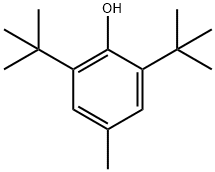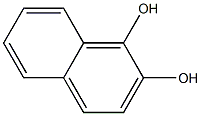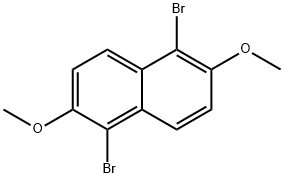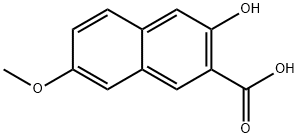2,6-Naphthalenediol
Synonym(s):2,6-Naphthalenediol
- CAS NO.:581-43-1
- Empirical Formula: C10H8O2
- Molecular Weight: 160.17
- MDL number: MFCD00004082
- EINECS: 209-465-6
- SAFETY DATA SHEET (SDS)
- Update Date: 2024-12-18 14:08:57

What is 2,6-Naphthalenediol ?
The Uses of 2,6-Naphthalenediol
2,6-Dihydroxynaphthalene is used in the preparation of 1,5-dichloro-2,6-diethynylnaphthalenes. It is used to produce convulsions in mice. It exhibits antiproliferative activity towards certain cells. It is also employed in the preparation of the first-generation rotaxane dendrimer. Further, it is used in the production of several dyes, pigments, fluorescent whiteners, tanning agents, antioxidants and antiseptics. In addition to this, it is converted into amines, esters, ethers and carboxylic derivatives.
Synthesis
2,6-Naphthalenediol [581-43-1], 2,6- naphthohydroquinone, mp 222℃, is synthesized by potassium hydroxide fusion of 2-hydroxynaphthalene-6-sulfonic acid at 295℃. It undergoes amination at 250℃ to give 2,6-naphthalenediamine and couples with diazotized anilines in the 1-position under acid conditions or the 1,5- positions under alkaline conditions.
Properties of 2,6-Naphthalenediol
| Melting point: | 223-225 °C(lit.) |
| Boiling point: | 246.06°C (rough estimate) |
| Density | 1.0924 (rough estimate) |
| refractive index | 1.5418 (estimate) |
| storage temp. | Inert atmosphere,Room Temperature |
| solubility | DMSO (Slightly), Methanol (Slightly) |
| form | Solid |
| pka | 9.55±0.40(Predicted) |
| color | White to Off-White |
| Water Solubility | Soluble in methanol and hot water. Slightly soluble in water. |
| BRN | 1238082 |
| CAS DataBase Reference | 581-43-1(CAS DataBase Reference) |
| NIST Chemistry Reference | 2,6-Dihydroxynaphthalene(581-43-1) |
| EPA Substance Registry System | 2,6-Naphthalenediol (581-43-1) |
Safety information for 2,6-Naphthalenediol
| Signal word | Warning |
| Pictogram(s) |
 Exclamation Mark Irritant GHS07 |
| GHS Hazard Statements |
H315:Skin corrosion/irritation H319:Serious eye damage/eye irritation H335:Specific target organ toxicity, single exposure;Respiratory tract irritation |
| Precautionary Statement Codes |
P261:Avoid breathing dust/fume/gas/mist/vapours/spray. P264:Wash hands thoroughly after handling. P264:Wash skin thouroughly after handling. P271:Use only outdoors or in a well-ventilated area. P280:Wear protective gloves/protective clothing/eye protection/face protection. P302+P352:IF ON SKIN: wash with plenty of soap and water. P305+P351+P338:IF IN EYES: Rinse cautiously with water for several minutes. Remove contact lenses, if present and easy to do. Continuerinsing. |
Computed Descriptors for 2,6-Naphthalenediol
New Products
4-Fluorophenylacetic acid 4-Methylphenylacetic acid N-Boc-D-alaninol N-BOC-D/L-ALANINOL Tert-butyl bis(2-chloroethyl)carbamate 3-Morpholino-1-(4-nitrophenyl)-5,6-dihydropyridin- 2(1H)-one Furan-2,5-Dicarboxylic Acid Tropic acid S-2-CHLORO PROPIONIC ACID ETHYL ISOCYANOACETATE 2-Bromo-1,3-Bis(Dimethylamino)Trimethinium Hexafluorophosphate (6-METHYL-[1,3]DITHIOLO[4,5-b]QUINOXALIN-2-ONE INDAZOLE-3-CARBOXYLIC ACID 4-IODO BENZOIC ACID (2-Hydroxyphenyl)acetonitrile 4-Bromopyrazole 5,6-Dimethoxyindanone 2-(Cyanocyclohexyl)acetic acid 4-methoxy-3,5-dinitropyridine 2-aminopropyl benzoate hydrochloride 1-(4-(aminomethyl)benzyl)urea hydrochloride diethyl 2-(2-((tertbutoxycarbonyl)amino) ethyl)malonate tert-butyl 4- (ureidomethyl)benzylcarbamate Ethyl-2-chloro((4-methoxyphenyl)hydrazono)acetateRelated products of tetrahydrofuran








You may like
-
 2,6-Dihydroxynaphthalene CAS 581-43-1View Details
2,6-Dihydroxynaphthalene CAS 581-43-1View Details
581-43-1 -
 2,6-Dihydroxynaphthalene CAS 581-43-1View Details
2,6-Dihydroxynaphthalene CAS 581-43-1View Details
581-43-1 -
 1975-50-4 98%View Details
1975-50-4 98%View Details
1975-50-4 -
 2-HYDROXY BENZYL ALCOHOL 98%View Details
2-HYDROXY BENZYL ALCOHOL 98%View Details
90-01-7 -
 2-Chloro-1,3-Bis(Dimethylamino)Trimethinium Hexafluorophosphate 221615-75-4 98%View Details
2-Chloro-1,3-Bis(Dimethylamino)Trimethinium Hexafluorophosphate 221615-75-4 98%View Details
221615-75-4 -
 61397-56-6 CIS BROMO BENZOATE 98%View Details
61397-56-6 CIS BROMO BENZOATE 98%View Details
61397-56-6 -
 14714-50-2 (2-Hydroxyphenyl)acetonitrile 98+View Details
14714-50-2 (2-Hydroxyphenyl)acetonitrile 98+View Details
14714-50-2 -
 118753-70-1 98+View Details
118753-70-1 98+View Details
118753-70-1